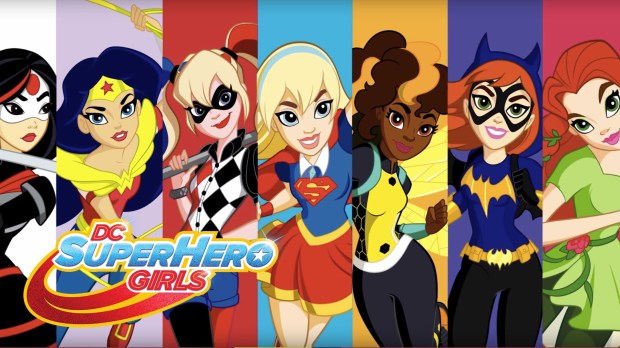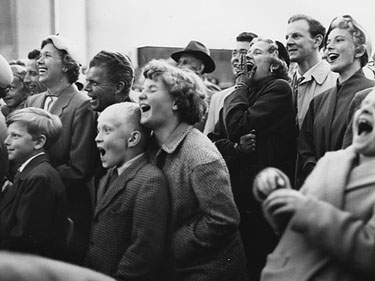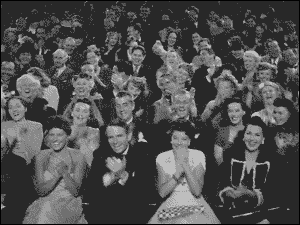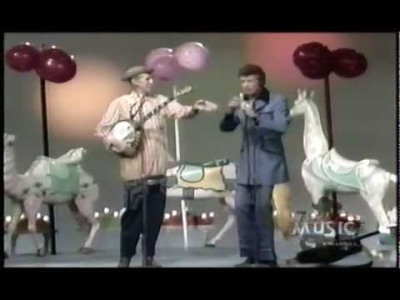Milquetoast
As a blogger for American Humor Studies, I run an occasional series that explains the etymology of words that derive from humorous sources–particularly cartoons. It is fascinating how the words transition from neologisms that perform a particular task for the cartoonist, but are eventually adopted by the public, sometimes for a short period (as the following word was) and sometimes for hundreds of years (as “gerrymander” has been).
The last time I saw “milquetoast” or any form of the word was back in the 1970s. A coworker of mine mocked up a nameplate for one of our bosses that said “Casper Milktoast” and had put it on his desk. After asking him how he had come up with the name, he told me it was a term that his grandfather had used. It was later that I encountered it in a book of H. T. Webster cartoons.
“Milquetoast” is a derisive term for a timid, unassertive person. It comes from a Webster cartoon character named Caspar Milquetoast. Although the word is spelled “milque,” it undoubtedly refers to “milk” and the effect that milk and other liquids have on bread when it is dipped in them. The bread, or toast, becomes soggy and malleable, and Webster named his soggy, malleable character for that phenomenon.

“The Timid Soul” pen and ink cartoon by Harold Tucker Webster in The Best of H. T. Webster by Robert E. Sherwood and Philo Calhoun. New York: Simon and Schuster 1953.
Why milk? Why not water? Milk is white, and men who have a white complexion are considered less rugged than those who have darker, tanned complexions. Combine that whiteness with sogginess and the term is less than flattering for a man. The interwar period was a time of racism in the United States with many symbols that represented perceived characteristics of blacks and whites. The symbol of paleness as representative of non-assertiveness supports the concept that blacks were rugged laborers and whites were among the leisure classes, but too much leisure and time out of the sun was perceived as unmanly. It is no surprise that cartoonists often exploit stereotypes to reinforce the hidden suggestions within the text and images.
Caspar Milquetoast first appeared in Webster’s cartoons in 1924, but it was not until 1935 that it became a noun describing a timid soul. It may have derived from the term “milksop,” which originated in the 14th century and is also defined as a man who is unassertive. The name Casper was appropriated in 1939 by a new cartoon character called Casper (McFadden) the Friendly Ghost. With only the difference of the single vowel, both Casp(a)ers were blanched and timid. The word Casp(a)er derives from an Indo-European word for “treasurer” and is formerly related to gold. However, because of the friendly ghost and milquetoast, Casp(a)er is now associated with paleness and the eschewing of the rough and tumble world of the outdoors. As a possible result, neither form of the word “Casp(a)er” has been on the list of the top 1,000 baby names in many years.
Introspecting with John Ashbery
Yesterday (April 20, 2016) marked the 20th anniversary of National Poetry Month. This annual event, created by The Academy of American Poets, has become the largest literary celebration in the world. Click here to discover what poetic events are happening near you.
In that spirit of celebration, today’s piece is by a most celebrated poet. John Ashbery has published more than twenty volumes of poetry and won The Pulitzer Prize, The National Book Award, a MacArthur “Genius” Grant, and just about everything else I can think of.
Ashbery approaches the blank page the way a modern artist might approach a blank canvas. The words from his broad palette are applied with a bold hand. He’s incisive about human nature, sometimes poking fun at himself in a way that shows us our own funny human frailties as well.
This meandering stream-of-consciousness piece from the sixties is one of my favorites. Enjoy!
My Philosophy of Life Just when I thought there wasn’t room enough for another thought in my head, I had this great idea-- call it a philosophy of life, if you will. Briefly, it involved living the way philosophers live, according to a set of principles. OK, but which ones? That was the hardest part, I admit, but I had a kind of dark foreknowledge of what it would be like. Everything, from eating watermelon or going to the bathroom or just standing on a subway platform, lost in thought for a few minutes, or worrying about rain forests, would be affected, or more precisely, inflected by my new attitude. I wouldn’t be preachy, or worry about children and old people, except in the general way prescribed by our clockwork universe. Instead I’d sort of let things be what they are while injecting them with the serum of the new moral climate I thought I’d stumbled into, as a stranger accidentally presses against a panel and a bookcase slides back, revealing a winding staircase with greenish light somewhere down below, and he automatically steps inside and the bookcase slides shut, as is customary on such occasions. At once a fragrance overwhelms him--not saffron, not lavender, but something in between. He thinks of cushions, like the one his uncle’s Boston bull terrier used to lie on watching him quizzically, pointed ear-tips folded over. And then the great rush is on. Not a single idea emerges from it. It’s enough to disgust you with thought. But then you remember something William James wrote in some book of his you never read--it was fine, it had the fineness, the powder of life dusted over it, by chance, of course, yet still looking for evidence of fingerprints. Someone had handled it even before he formulated it, though the thought was his and his alone. It’s fine, in summer, to visit the seashore. There are lots of little trips to be made. A grove of fledgling aspens welcomes the traveler. Nearby are the public toilets where weary pilgrims have carved their names and addresses, and perhaps messages as well, messages to the world, as they sat and thought about what they’d do after using the toilet and washing their hands at the sink, prior to stepping out into the open again. Had they been coaxed in by principles, and were their words philosophy, of however crude a sort? I confess I can move no farther along this train of thought-- something’s blocking it. Something I’m not big enough to see over. Or maybe I’m frankly scared. What was the matter with how I acted before? But maybe I can come up with a compromise--I’ll let things be what they are, sort of. In the autumn I’ll put up jellies and preserves, against the winter cold and futility, and that will be a human thing, and intelligent as well. I won’t be embarrassed by my friends’ dumb remarks, or even my own, though admittedly that’s the hardest part, as when you are in a crowded theater and something you say riles the spectator in front of you, who doesn’t even like the idea of two people near him talking together. Well he’s got to be flushed out so the hunters can have a crack at him-- this thing works both ways, you know. You can’t always be worrying about others and keeping track of yourself at the same time. That would be abusive, and about as much fun as attending the wedding of two people you don’t know. Still, there’s a lot of fun to be had in the gaps between ideas. That’s what they’re made for! Now I want you to go out there and enjoy yourself, and yes, enjoy your philosophy of life, too. They don’t come along every day. Look out! There’s a big one... -- John Ashbery
Hand-Held Harlequins! : The Super-Humor of DC’s New Girl Powered Action Franchise
“Get your cape on, and let’s take flight! We can be who we like!” – DC Super Hero Girls theme song.

My daughter is a Caped Crusader.
Even in her toddler phase, she always preferred colorful costumes and cataclysmic combat over Barbification or Dora-mania. Yet, as far as we can tell from her second grade peers and pals, she is not a “geek” or a “mean girl.” She’s not a tomboy either, since prim princesses and personified ponies and adamantly American Girls and absolutely anything related to Alex Morgan all fill a good quotient of her 8-year old day. She does quite well in school, just completed her First Communion, plays two sports with aplomb, and has recently survived her first ear piercings, not to mention a fairly brutal soccer-smashed fibula.
Yet, when she really wants to cut loose and get her missy mojo working, she always turns to cosplay. Over the years, she has done turns as Super-girl, Maleficent, Frozen‘s Queen Elsa (Elsa is, ironically, her actual name!) and Leia Organa, but her more recent repertoire includes Batgirl, the Scarlet Witch, the Wasp, and most especially of late, Cat Woman and Agent Carter.
She is hardly alone among her age group in her inclinations toward super-couture, and believe it or not, neither Mom nor I have had much influence on her passionate attraction to wonder-duds. In fact, there isn’t much superhero merch about the house beyond my basement hobbit hole of a Media Studies library. Nor are we a particularly super-duper family, aside from fond memories of the original Super Friends and the occasional spontaneous viewings of The Incredibles or Big Hero 6. For further proof, just ask my 10 year-old son, who completely skipped over all of the superhero genres and contexts that fascinated many of his friends. From his earlest safaris around our home, he has always favored scouts, birding, tennis, and baseball. So super-stuff abides in our lives, but it does not beckon, inundate, or restrict our offspring’s access to other forms of generally pleasant and genuinely good-hearted American middle class fun. Still, on her own time and in her own mind, my daughter is definitely a Super Hero Girl.
Laughing with Laugh Tracks

Teaching American Humor: Laughing with Laugh Tracks
My life would be better with a laugh track. My writing would be better, too. So would your reading experience–well, with a laugh track and a few drinks…
I am with the majority opinion on this issue, at least according to most producers of American situation comedies for the last sixty years. The reasoning behind the laugh track, as I see it, goes like this: A laugh track makes people laugh; people who laugh enjoy situation comedies; people who enjoy situation comedies see plenty of commercials; people who see commercials while in a good mood tend to buy things; a laugh track makes people laugh, and so on… Those who buy and sell commercials fund sitcoms, and they have never been inclined to trust writers or audiences. Neither do I.
I have skillfully written two first-rate jokes thus far. But, of course, you can’t really know that because this post does not have a laugh track. I spent several hours trying to insert laugh track audio here and failed. That’s funny–I think–but how can any of us be sure?

Teaching the American sitcom requires some discussion of laugh tracks. I admit that I have only glossed over laugh tracks in courses on American humor thus far. This has been a mistake. I have awakened to an obvious point: laugh tracks provide a compelling way for students to consider a more challenging array of characteristics of the art form–from the aesthetic to the mundane, from the heart of performance to the mechanics of production, from the implicit honesty of comedy to the manipulative potential of technology. From now on, I will begin all coursework focused on the sitcom with the laugh track.
Here is how I came to this astounding awakening; it’s all about The Big Bang Theory. I like the show (though I can’t decide whether I should consider it a “guilty pleasure” or an appreciation of solid, if broad, writing). The laugh track, however, drives me crazy. It is loud and intrusive. I don’t believe it at all. I am not alone. Any quick Google search of “laugh tracks” will provide over 31,000,000 hits. Type in “Big Bang Theory,” and you will find 127,000,000 hits, virtually all of which refer to the show (I didn’t check out all of them, by the way. I simply reached that conclusion using the scientific method based on my observations of the first two pages). Here is a fact: lots of people care about the television show; almost nobody cares about the scientific theory. A search of the show title combined with “laugh tracks” gets 181,000 hits. Lots of people hate the laugh track (lots of people hate the show, too). YouTube has plenty of clips of the show with the laugh track removed. Here are two examples:
http://www.youtube.com/watch?v=PmLQaTcViOA
http://www.youtube.com/watch?v=ASZ8Hks4gko
These clips draw out two basic responses from interested parties: one, that the show is hurt by the laugh track (so the complaint concerns its use rather than the inherent quality of the show itself); two, that the laugh track lamely attempts to cover up a lousy show. There is no reconciling of these opposing positions, but the removal of the laugh track is disingenuous in that it creates a show wherein the comedic timing has been wholly distorted. The Big Bang Theory is filmed in front of a live audience, and the performance reflects the interaction between audience and cast. The producers of the show claim that the audience responses are genuine and have not been “sweetened,” a term to imply that the laughter has been engineered in production to enhance audience responses. This claim is disingenuous as well. Any production process will inevitably “sweeten” the final product–from placement of microphones to volume applied. All steps in the process of preparing a show for airing are a form of “sweetening.” Simply because the producers do not use canned laughter (laughter recordings NOT from an live audience) does not mean that no laughter manipulation occurs. Of course it does. As always, The Onion provides the best satirical take on laugh tracks with the show by simply raising the volume of the laugh track so that it wholly overpowers the show itself: Big Bang Theory with laugh track enhanced by The Onion
Stringbean: Me and My Old Crow and a Letter from Home
 Last month, I wrote about David “Stringbean” Akeman’s life and murder. Here’s a clip of Stringbean in action picking a song and a doing one of his trademark “letter from home” bits with host Del Reeves, who seems to be feeling no pain. Stringbean and his wife were murdered a few years later when they ambushed burglars after playing the Grand Ole Opry.
Last month, I wrote about David “Stringbean” Akeman’s life and murder. Here’s a clip of Stringbean in action picking a song and a doing one of his trademark “letter from home” bits with host Del Reeves, who seems to be feeling no pain. Stringbean and his wife were murdered a few years later when they ambushed burglars after playing the Grand Ole Opry.
Hagiography
RIP Merle.
 They say imitation is the sincerest form of flattery. Most great musicians develop their style by first imitating their musical heroes. This is especially true in country music. Ray Price was little more than a Hank Williams sound-alike until he eventually developed his own unique and influential sound. Ernest Tubb tried to sing like Jimmie Rodgers but a tonsillectomy caused him to end up sounding like, well, Ernest Tubb. Lefty Frizzel also tried to sound like Jimmie Rodgers, but his sweet, sliding way of singing resulted in yet another distinctive voice. Merle Haggard, who idolized Lefty’s singing, tried to emulate his style and ended up creating what is arguably the single most influential voice in country music.
They say imitation is the sincerest form of flattery. Most great musicians develop their style by first imitating their musical heroes. This is especially true in country music. Ray Price was little more than a Hank Williams sound-alike until he eventually developed his own unique and influential sound. Ernest Tubb tried to sing like Jimmie Rodgers but a tonsillectomy caused him to end up sounding like, well, Ernest Tubb. Lefty Frizzel also tried to sound like Jimmie Rodgers, but his sweet, sliding way of singing resulted in yet another distinctive voice. Merle Haggard, who idolized Lefty’s singing, tried to emulate his style and ended up creating what is arguably the single most influential voice in country music.
One of our greatest feats as sophisticated beings is our ability to laugh at ourselves, in spite of ourselves. Merle Haggard’s life is the stuff of great fiction: born in a boxcar in Oildale, California to…
View original post 261 more words





